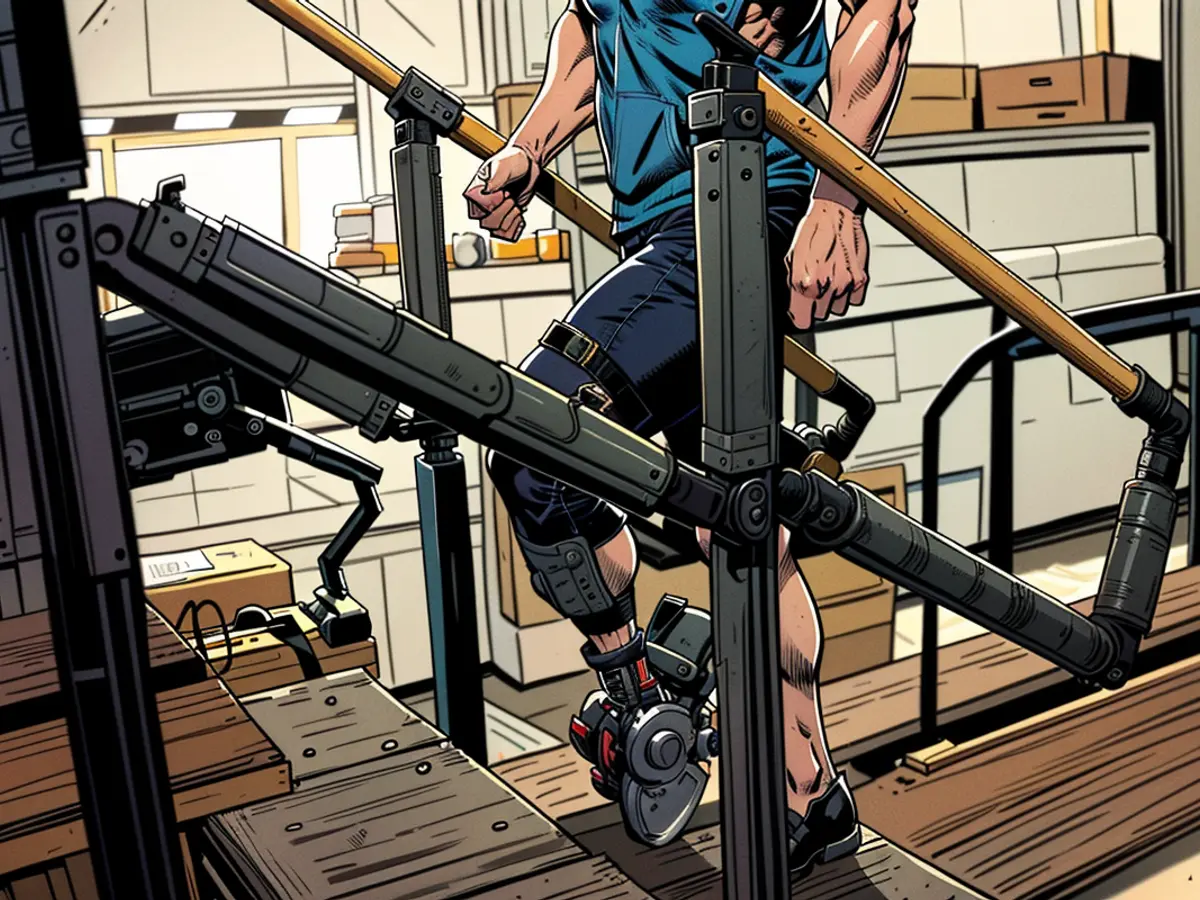Bionic leg restores natural walking speeds and steps: ‘I didn’t feel like my leg had been amputated’
First was as a child and then after an industrial burn led to the amputation of her left leg in 2018. Since then, she’s had “first steps” in prosthetic legs for running, water, high heels, rowing and everyday walking.
Her latest “first steps” were different. This time, she was fitted with a bionic leg that was fully connected to her brain, allowing her to walk and move like anyone else. With this new leg, she said, she couldn’t even tell there was a difference.
“I didn’t feel like my leg had been amputated,” the 47-year-old from Massachusetts said. “It was the happiest moment in my life.”
Pietrafitta was part of a study of a new neuroprosthesis from the Massachusetts Institute of Technology that’s fully controlled by the nervous system. Her leg had been amputated using a novel muscle-pairing technique called agonist-antagonist myoneural interface, or AMI, which preserves signaling between the muscles and the brain.
The neuroprosthesis uses sensors placed between the reconstructed amputation site and the bionic leg to transmit electrical signals from the brain. This allows the prosthetic to sense its position and movement and to send this information back to the patient, enabling a sense of proprioception: the brain’s ability to sense self-movement and location in space.
The study, published Monday in the journal Nature Medicine, indicated that participants who’d had the specialized amputation and neuroprosthesis increased their walking speed 41%, matching the ranges and abilities of people without leg amputations. The results also suggested that the bionic limb could be controlled using just 18% of natural proprioception.
This is the first bionic leg fully controlled by the human nervous system to demonstrate natural walking speeds and gait patterns, according to Dr. Hugh Herr, principal investigator and senior author of the study and co-lead of the Yang Center for Bionics at MIT, where the research took place.
“It feels natural, as if the limb were made of flesh and bone. It’s as if the central brain isn’t aware the limb is amputated because the brain is getting normal sensations,” said Herr, who had both legs amputated below the knee after a climbing accident in 1982.

Herr embarked on the project after observing a trend of prosthetics being increasingly controlled by robotic algorithms rather than the human nervous system.
“We want to rebuild human bodies,” he said. “We want to reconstruct and give people back what they so seek. We don’t just want to build fancier and fancier robotic tools or devices.”
To test the interface, 14 participants were split into two groups and fitted with bionic prosthetic legs. Seven had undergone AMI surgery, and seven had not.
The results suggested that those with AMI amputations navigated real-world environments better, including slopes, stairs, obstructed pathways and even an “American Ninja Warrior”-style course, according to Pietrafitta and Dr. Matthew J. Carty, the lead surgeon in the first AMI procedure and a former research scientist at the MIT Media Lab.
“This is a fundamental paradigm shift in the way we think about amputation in conjunction with technology: treating it as a restorative procedure as opposed to a failure,” Carty said.
Beyond first steps
The technology also allows users to switch between speeds without changing prosthetics. This reduces the hassle of swapping legs, avoids unwanted attention and restores a sense of normalcy, according to Pietrafitta.
“It felt normal. ... I was ready to run. I kept wanting to take my hands off [the supports], to get out and start moving,” she said.
Restoring a normal gait is about more than getting from point A to point B. According to Pietrafitta, it’s about re-entering society.
“It meant my life could begin again. ... I could go out there and live the way I wanted to,” she said. “When you’re in your home and you’re bedridden, family and friends start to dwindle away. It’s too hard for people to come in and see you in pain.”
For John Rheinstein, a lower and upper limb prosthetic specialist and clinic manager at the Hanger Clinic in New York, the physical prosthesis is only part of a successful amputation outcome.
“Care has improved over the years (in part) as a result of advances in understanding and treating the emotional impacts of losing a limb,” he wrote in an email.
Is innovation accessible?
An estimated 1.9 million Americans live with limb loss, a figure expected to double by 2050, largely due to increasing rates of diabetes, a known risk factor, according to a 2018 report published by the federal Agency for Healthcare Research and Quality.
Herr said his team aims to make fully neuro-controlled prosthetics commercially available within five years. However, the 2018 report estimates that fewer than half of people with amputations receive prosthetic prescriptions.
People with amputations may struggle to get prescriptions and insurance coverage for prosthetic devices, especially for options with more advanced technology. Rheinstein cites insurance coverage for prosthetic limbs — specifically the lack of coverage for activity-specific prosthetics — as one of the most difficult parts of his patients’ rehabilitation journeys.
“Demonstrating to payers the value of the outcomes we provide and how outcomes-based prosthetic care reduces overall healthcare costs” is one of the biggest challenges the industry faces today, he said.
For example, the BionX emPOWER prosthetic is the only motor-driven prosthetic on the market, according to Herr, and many people with limb loss aren’t able to access it.
Although AMI neuroprostheses aren’t available to the public, the AMI surgery has been performed on about 60 people around the world, according to Herr.
Get CNN Health's weekly newsletter
- Sign up here to get The Results Are In with Dr. Sanjay Gupta every Tuesday from the CNN Health team.
At the Brigham and Women’s Hospital in Boston, where Carty is a staff surgeon in the Division of Plastic Surgery, AMI is now the standard of care for amputations, Carty said.
“The [hospital’s] ethical board determined it’s unethical to offer the standard amputation, because we now know the AMI amputation is so beneficial,” Herr said. “We hope it’ll be standard not only in Boston, but in clinical sites all over the world.”
The more surgeons, prosthetists, researchers and patients work together on new developments, the better, according to Rheinstein, who hopes the AMI technique will “bring attention to the importance of thoughtfully planned amputation surgery to a patient’s successful rehabilitation.”
“Hollywood for decades has given us visions of these remarkable bionic humans ... but science reality has been slower than science fiction,” Herr added.
“We’re finally producing systems that we’ve seen in the movies.”
The use of the AMI technique for amputations has been shown to significantly improve mobility, as indicated by the study participants increasing their walking speed by 41% and matching the abilities of people without leg amputations. With this new technology, individuals like Pietrafitta can experience a sense of normalcy and re-enter society with confidence.
Moreover, the bionic leg allows users to switch between speeds without needing to change prosthetics, reducing unwanted attention and restoring a sense of regularity in their daily lives. According to Pietrafitta, this technology is more than just helping her move, it's about regaining her place in society.








